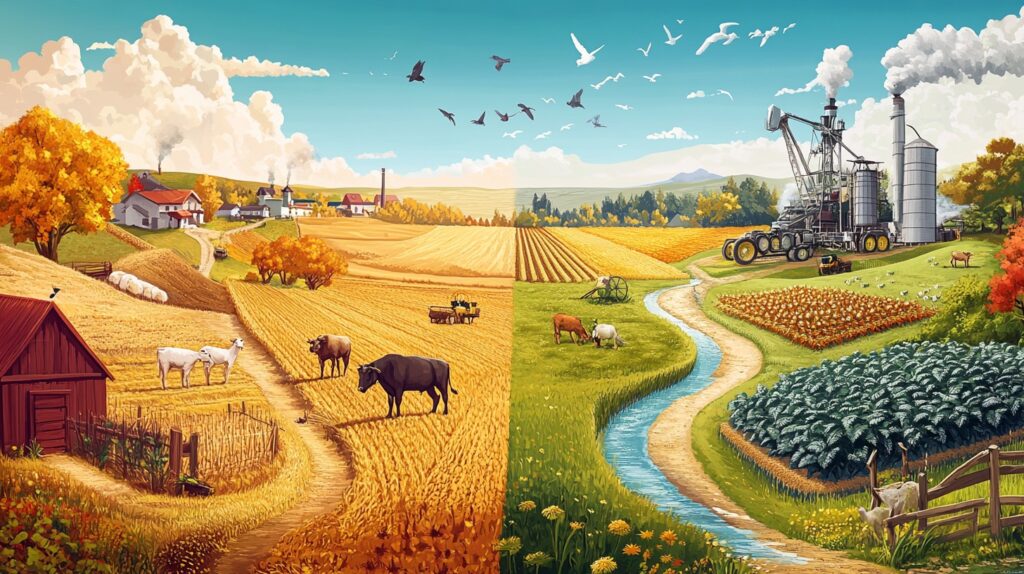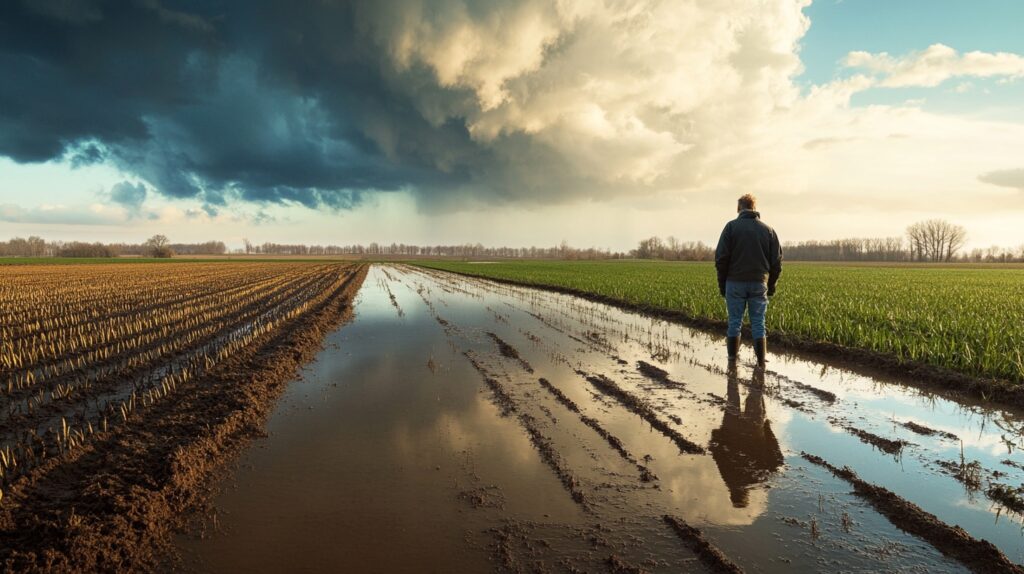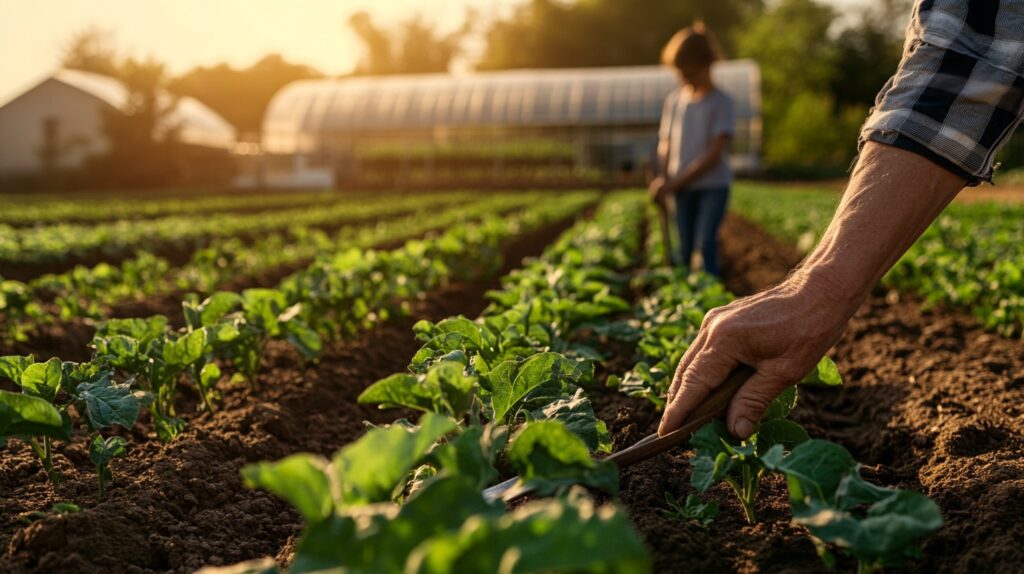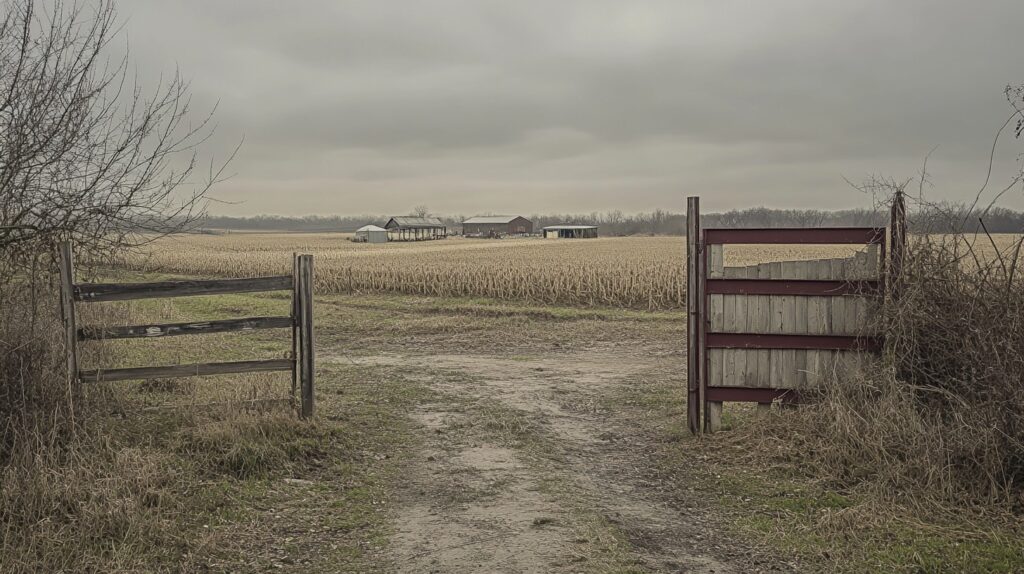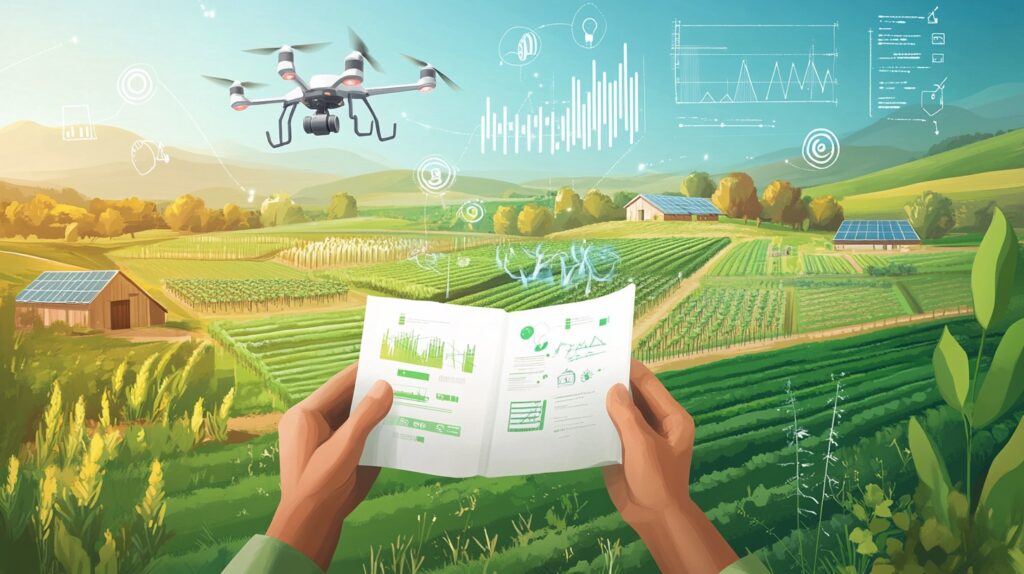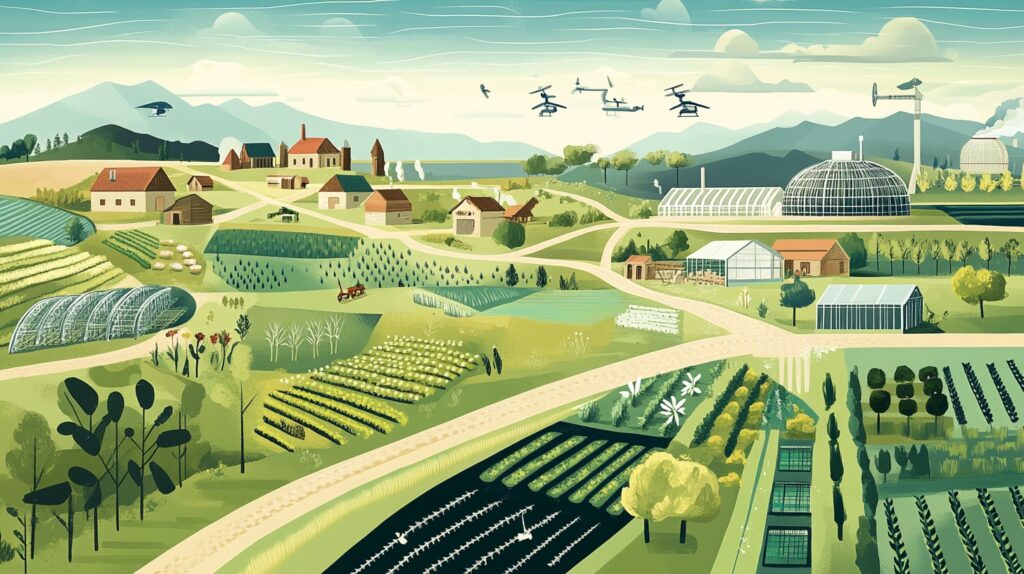This blogpost, Monocropping and Precision Agriculture: A Path to Sustainable Farming from the Grand Friend Project, was created by the GrandFriend consortium. Grandfriend is an EU Funded project named “Intergenerational Hub for the Amelioration of Sustainable Agricultural Practices and Entrepreneurial Mindset” with the reference number 2022-1-DE02-KA220-ADU-000085106. L4Y Learning for Youth GmbH coordinates it with the partners KMOP, Polish Farm Advisory, Citizens in Power, Challedu.
Learn more by accessing the home page of the project. Alternatively, follow us on LinkedIn, as well as Facebook social media pages.
Learning Objectives for Monocropping and Precision Agriculture
- Firstly, improve young people’s understanding of environmentally friendly agricultural practices. Moreover, focus on raising awareness among older generations.
- Secondly, raise senior citizens’ awareness of sustainable food production by linking modern precision agriculture techniques to past traditional practices.
- In addition, encourage citizens of all ages to engage in environmental and agricultural sustainability discussions.
- Moreover, bridge generational gaps in agricultural knowledge through technology and tradition.
- Finally, inspire local and global initiatives aimed at sustainable food systems.
Introduction to Monocropping and Precision Agriculture
Monocropping has been a dominant farming method for centuries, especially in industrial agriculture. While this method streamlines operations and increases production, it raises ecological concerns that cannot be overlooked. Modern precision agriculture offers a solution, enabling farmers to enhance monocropping efficiency while addressing sustainability challenges. Therefore, this article explores the definition of monocropping, its benefits and challenges, and how precision agriculture can transform the practice into a more sustainable system. By connecting younger generations to technology and older generations to traditional sustainable approaches, a collective effort can reshape the future of agriculture (Food and Agriculture Organization [FAO], 2023).
Moreover, monocropping’s prevalence has sparked debates among environmentalists, policymakers, and farmers, leading to the development of innovative practices. These discussions emphasize the importance of balancing productivity with ecological responsibility. Through the integration of cutting-edge technologies and timeless farming principles, agriculture can address growing demands while fostering environmental resilience.
Definition of Monocropping
Monocropping, or the cultivation of a single crop on the same land year after year, is common in industrial farming. For example, crops such as corn, soybeans, and wheat dominate monoculture systems due to their high market demand and scalability (Britannica, 2023). While the approach reduces complexity in operations, it poses ecological challenges such as soil degradation, pest vulnerability, and biodiversity loss (EOS, 2023).
This practice, despite its challenges, remains indispensable in meeting global food demands. Understanding monocropping’s underlying mechanics and its impact on ecosystems provides the foundation for developing more sustainable agricultural systems. By contextualizing monocropping within modern and historical farming practices, farmers can learn to mitigate its negative effects while optimizing its benefits.
Advantages of Monocropping
Economies of Scale
Monocropping supports large-scale production, reducing costs for seeds, labour, and equipment. In addition, this system allows farmers to specialise in a single crop, increasing efficiency and lowering production expenses (Food Revolution Network, 2023). Additionally, economies of scale enable easier coordination of logistics, distribution, and market integration, ensuring global food supply chains remain robust.
Streamlined Operations
Simplified processes such as planting, maintenance, and harvesting make it easier for farmers to focus on optimising yield. This efficiency ensures consistent supply to meet market demands (Fiveable, 2023). For example, advanced machinery tailored for specific crops allows for faster planting and harvesting, reducing labour costs and time.
Market Specialisation
Farmers can build their businesses around a single crop, allowing them to develop expertise and gain reliable revenue streams by meeting specific market needs (ResearchGate, 2023). Specialisation also fosters innovation, as farmers refine techniques for enhancing crop quality, increasing their competitive edge in the global marketplace.
Challenges and Drawbacks of Monocropping and Precision Agriculture
Soil Degradation
Repeated cultivation of the same crop depletes soil nutrients, leading to reduced fertility. Consequently, over time, this necessitates greater reliance on synthetic fertilisers to maintain productivity (Wiley, 2023). The cycle of nutrient depletion and artificial replenishment can disrupt soil microbial ecosystems, further exacerbating long-term sustainability issues.
Pest & Disease Vulnerability
Large-scale monocultures become susceptible to pests and diseases specific to the cultivated crop, requiring increased pesticide use and raising environmental concerns (FAO, 2023). As a result, the lack of genetic diversity within monoculture systems creates an ideal environment for pests to thrive, potentially leading to widespread crop failures.
Biodiversity Loss
Monocropping limits habitat diversity, negatively affecting beneficial insects, pollinators, and wildlife. This, in turn, can reduce natural pest control and pollination services (Britannica, 2023). A decline in biodiversity also impacts soil health and resilience, making ecosystems more vulnerable to climate change.
Role of Precision Agriculture in Enhancing Monocropping Efficiency
Data-Driven Decisions
Precision tools such as GPS mapping, drones, and soil sensors allow farmers to monitor crop conditions and soil health in real time. Furthermore, these insights enable timely interventions to optimise growth (Wiley, 2023). Moreover, real-time analytics empower farmers to predict trends, ensuring proactive rather than reactive management.
Variable Rate Application
Farmers can tailor the use of water, fertilisers, and pesticides based on specific field conditions, minimising waste and environmental impact (EOS, 2023). This approach not only conserves resources but also reduces operational costs, making farming more sustainable and profitable.
Automated Machinery
Self-driving tractors and robotic harvesters enhance efficiency and reduce labour costs, making monocropping more manageable on a large scale with the use of precision agriculture (Food Revolution Network, 2023). Automation also reduces human error, ensuring consistent performance and improving overall crop quality.
Remote Sensing
Satellite imagery and drone technology detect crop stress and nutrient deficiencies early, preventing widespread issues (FAO, 2023). These technologies contribute to predictive maintenance, helping farmers identify and address potential problems before they escalate.
Higher Yields Through Precision Agriculture Techniques
Soil Monitoring
Soil testing helps apply only the necessary nutrients, preventing over-fertilisation and promoting long-term soil health (ResearchGate, 2023). Enhanced soil management strategies also encourage the adoption of cover crops, which restore organic matter and improve fertility.
Targeted Pest Control
Sensor technology allows for pesticide application only where pests are detected, reducing chemical use and environmental impact (Britannica, 2023). Furthermore, targeted pest control strategies can include integrated pest management, combining biological and chemical methods for greater efficiency.
Water Management
Advanced irrigation systems like drip irrigation ensure crops receive precise amounts of water, reducing waste and improving efficiency (EOS, 2023). Thus, these systems can be paired with weather forecasting tools to optimise irrigation schedules and conserve water resources.
Genetic Selection
Biotechnology enables farmers to select crop varieties suited to their soil and climate conditions, improving yields while minimising resource use (Wiley, 2023). Advances in genetic engineering also provide crops with enhanced resistance to pests, diseases, and extreme weather.
Sustainability Considerations of Monocropping and Precision Agriculture
Reduced Chemical Use
Precision agriculture minimises the need for pesticides and fertilisers, reducing pollution and conserving ecosystems (FAO, 2023). As a result, by limiting chemical dependency, farmers can contribute to healthier ecosystems and safer food production practices.
Improved Soil Health
Incorporating rotational monocropping or cover cropping alongside precision techniques can mitigate soil degradation (Food Revolution Network, 2023). Additionally, these practices enhance organic matter content, improving soil’s ability to retain water and nutrients.
Conservation of Resources
Efficient resource management reduces water consumption and energy use, lowering agriculture’s carbon footprint (Wiley, 2023). Resource conservation also supports climate adaptation strategies, helping farmers address the challenges of a warming planet.
Economic Impacts of Monocropping and Precision Agriculture
Profitability
Although precision agriculture involves high initial investments, reduced input costs and higher yields result in long-term financial benefits (ResearchGate, 2023). Farmers adopting these methods often report improved financial stability and greater market competitiveness.
Risk Management
Access to real-time data allows farmers to adapt quickly to environmental changes, mitigating risks and reducing crop loss (EOS, 2023). Predictive analytics further enhances risk mitigation, enabling farmers to safeguard their investments effectively.
Market Advantage
Producing high-quality crops through precision techniques can open doors to premium markets and long-term contracts with buyers (Fiveable, 2023). Additionally, precision methods support certifications for sustainable practices, increasing consumer trust.
Future Outlook for Monocropping and Precision Agriculture
Emerging Technologies
Innovations in AI, robotics, and machine learning will further refine precision agriculture, making it more accessible to farmers worldwide (Britannica, 2023). As a result, these advancements promise greater scalability, transforming how food systems operate globally.
Scalable Solutions
As technology becomes more affordable, smaller-scale farmers will adopt these methods, enhancing global food production efficiency (FAO, 2023). Community-based initiatives can further support equitable access to these technologies.
Regenerative Approaches
Integrating precision agriculture with regenerative practices like reduced tillage and agroforestry can create a sustainable balance between yield and environmental care (Food Revolution Network, 2023). In addition, these approaches enhance carbon sequestration, contributing to climate change mitigation.
Policy and Collaboration
Meanwhile, government support, subsidies, and farmer education are crucial for widespread adoption of precision agriculture, ensuring sustainable monocropping practices for future generations (Wiley, 2023). Collaborative efforts between stakeholders can accelerate the transition to greener agricultural systems.
Success Stories and Analogies on Monocropping and Precision Agriculture
Connecting Generations
Imagine a small farming village where older farmers used rotational cropping to maintain soil fertility. Today, younger farmers in the same village integrate drones and sensors into these traditional methods, creating a hybrid system. This collaboration not only improves efficiency but also preserves the wisdom of the past. By combining generational expertise, these communities demonstrate the potential of innovation-driven sustainability.
Real-Life Success
The John Deere company has reported that precision agriculture tools such as GPS-guided tractors have enabled farmers in the US to reduce input costs by up to 20% while increasing yields by 15% (John Deere, 2022). These success stories highlight the transformative potential of technology in addressing agricultural challenges.
Resources for Learning about Monocropping and Precision Agriculture
Websites:
- FAO on Precision Agriculture
- EOS Blog on Sustainable Farming
- ResearchGate on Agricultural Innovations
Books:
- “Precision Agriculture for Sustainability and Environmental Protection” by J.L. Hatfield.
- “The Omnivore’s Dilemma” by Michael Pollan.
- “Regenerative Agriculture” by Mark Shepard.
Courses:
- Online course: “Precision Agriculture” by Coursera.
- Workshops by local agricultural extension offices.
- Seminars on sustainable farming by FAO.
Conclusion and Call to Action for Monocropping and Precision Agriculture
Monocropping remains a vital practice for feeding the world’s population, but its environmental challenges cannot be ignored. By combining traditional wisdom with modern precision agriculture, farmers can achieve higher yields while safeguarding the environment. It is time for citizens, regardless of age, to advocate for sustainable farming practices. Together, we can build a greener, more productive future.
A collective effort involving farmers, policymakers, scientists, and consumers is essential to drive meaningful change. As we navigate the complexities of modern agriculture, embracing innovation and tradition will pave the way for a resilient and sustainable food system. The future of farming depends on us all.
References for Monocropping and Precision Agriculture
- Britannica. (2023). Monoculture. Retrieved from https://www.britannica.com/topic/monoculture
- EOS. (2023). Blog on monoculture farming. Retrieved from https://eos.com/blog/monoculture-farming/
- FAO. (2023). Precision agriculture technologies for sustainable farming. Retrieved from https://www.fao.org
- Fiveable. (2023). Monocropping and its economic impact. Retrieved from https://library.fiveable.me
- Food Revolution Network. (2023). Sustainable farming practices. Retrieved from https://foodrevolution.org
- John Deere. (2022). Precision agriculture solutions. Retrieved from https://www.deere.com
- ResearchGate. (2023). Advances in precision agriculture. Retrieved from https://www.researchgate.net
- Wiley Online Library. (2023). Agricultural innovations for sustainability. Retrieved from https://onlinelibrary.wiley.com






